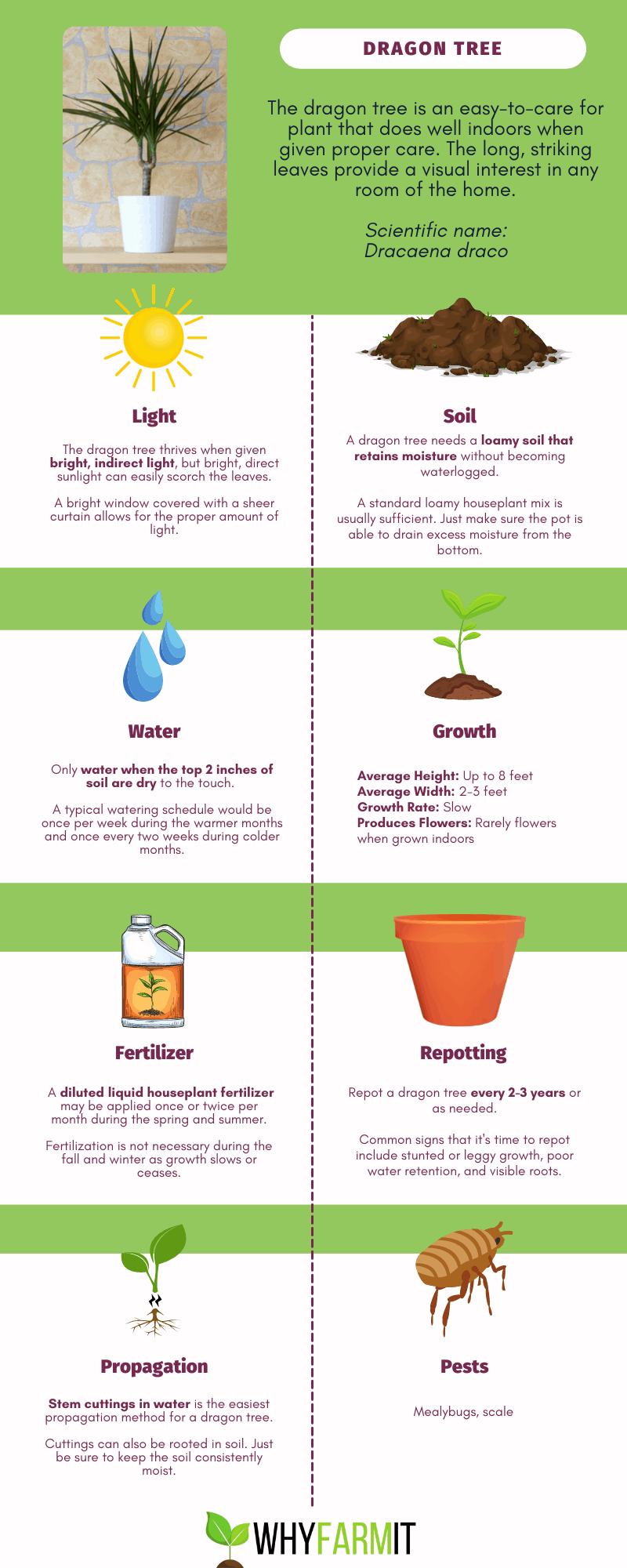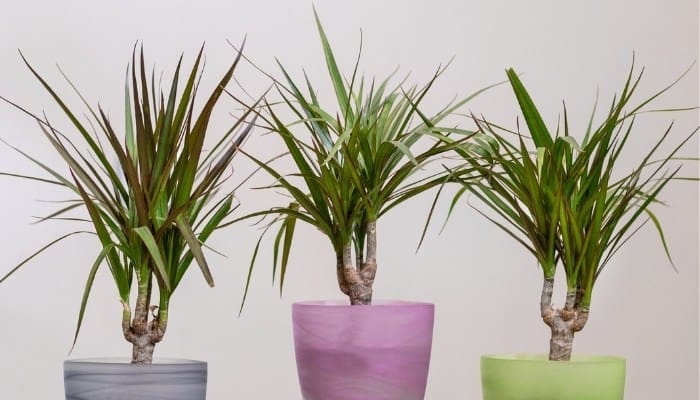The name of dragon trees comes from the tale of Hercules defeating the 100-headed dragon.
In the wild, these plants have multiple vertical branches filled with spiky leaves. The trees also produce “dragon’s blood,” a thick red resin collected from the trunks.
With such an interesting story, it is no surprise that these plants have become a favorite in homes.
How do you care for a dragon tree? Dragon trees grown indoors do best in bright, indirect light and a loamy moisture-retaining soil that drains well. They prefer temperatures of 65-75℉ and average humidity levels. Water when the top 2 inches of soil is dry, and fertilize once or twice per month during the growing season.
Caring for Dragon Tree: Basic Guidelines
Not only will this interesting-looking plant add interest to your home, but it is also a recommended plant for air purifying.
Dragon trees are known for removing harmless compounds from the air. Add in the easy-going nature, and there is no reason not to add a dragon tree to your home.
Get a jump-start with a 1-2-foot or 3-4-foot starter tree, shipped right to you!
Complete Care Guide for Dragon Tree
The Dracaena genus contains many popular houseplants, but there are three species commonly called “dragon tree”: Dracaena draco, Dracaena marginata, and Dracaena arborea.
The care requirements are the same for the different species of dragon trees. The main differences between the species is location of origin and size of the plant.
Dragon Tree at a Glance
- Plant type: Tropical, perennial tree
- Scientific Name: Dracaena draco, Dracaena marginata, Dracaena arborea
- Average Height: Up to 8 feet (indoors)
- Average Width: 2-3 feet
- Growth Rate: Slow
- Produces Flowers: Rarely indoors
- Common Pests: Mealybug, scale
- Life Expectancy: 10+ years with good care
- Difficulty of Care: Easy
Ideal Soil for Dragon Tree
Dragon trees enjoy a good amount of moisture, so it is important to plant them in soil that retains water well but drains thoroughly too to prevent waterlogged conditions.
A loamy houseplant potting mix is usually suitable for these plants.
They prefer slightly acidic or neutral soil pH.
Dragon Tree Water Requirements
While these plants enjoy moisture, they do not like their roots to be sitting in water. It is best practice to water when the top 2 inches of soil are dry.
Check the soil before each watering. For most situations, you will need to water your dragon tree once a week.
During the winter, you may notice that the dragon tree is consuming less water and will not need to be watered as frequently.
A gift to houseplant owners is that dragon trees are drought tolerant.
Some owners have reported forgetting to water their plants for months at a time, and the plant recovers quickly once watering is resumed.
Dragon Tree Lighting Needs
Dragon trees prefer bright, indirect light. This is best achieved near a bright window or a sunny window with sheer curtains.
Direct sunlight can easily scorch the delicate leaves of the dragon tree.
Ideal Temperature and Humidity Range for Dragon Tree
The ideal temperature range for dragon trees is 65-75℉, but some plants prefer slightly warmer temperatures.
Most dragon trees can tolerate cold temperatures, but don’t be surprised if they drop some leaves.
Avoid drafty locations in the home or locations with large temperature swings.
Dragon trees need average to high humidity. You can increase the ambient humidity by misting the leaves occasionally.
Misting will also help prevent the leaves from getting crunchy. However, misting too frequently can lead to fungal infections, like leaf spot.
Best Location for Dragon Tree
The best location for an indoor dragon tree is near a bright, warm window.
To avoid direct sunlight, western- and southern-facing windows should be covered with a sheer curtain to filter the light.
Dragon Tree Growth Habits
Dragon trees are slow growers. They can take over 10 years to grow 5-6 feet tall. It is normal for the plant to lose older leaves as it produces new growth.
Fertilization Type & Schedule for Dragon Tree
During the growing season (spring and summer), use a diluted houseplant fertilizer for your dragon tree. Apply the fertilizer 1-2 times per month as needed.
Since growth slows dramatically during the winter, you can halt fertilizer until the following spring.
I use this organic fertilizer for my houseplants. It’s packed with micro and macro nutrients and is gentle yet effective.
Signs of Nutrient Deficiency
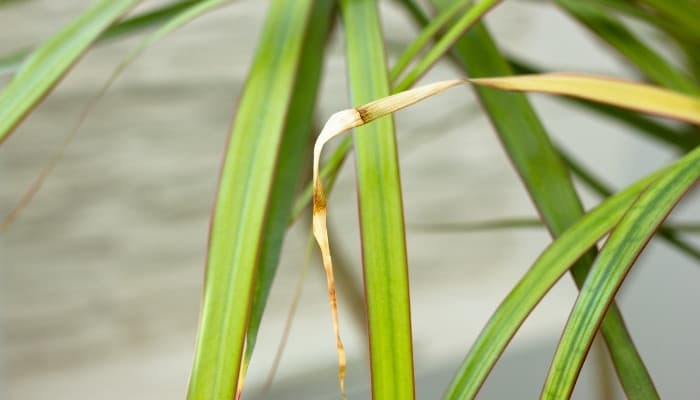
The most obvious sign of nutrient deficiency is yellowing leaves. Commonly, the lower (and therefore older) leaves will yellow and die off first, or the tips of the leaves could begin to yellow.
If you are not using a fertilizer, begin applying one as directed. It is important not to over-fertilize after seeing signs of nutrient deficiency.
Over-fertilization can also cause health problems for the plant.
Pruning a Dragon Tree
It is normal for dragon trees to lose their lower leaves as they grow and produce new leaves. You can remove these dying leaves as needed.
If any of your leaves get dry, brown tips, you can also trim the burned ends for aesthetic purposes.
To change the shape of your plant, you can easily prune off entire branches or trunks. In some cases, this will cause the dragon tree to produce a side branch below the trim.
Does Dragon Tree Produce Flowers?
Outdoors, dragon trees produce fragrant, white flowers. Once pollinated, the flowers then produce small yellow-orange berries.
Indoors, it is very rare for a dragon tree to bloom and even more rare for it to produce berries.
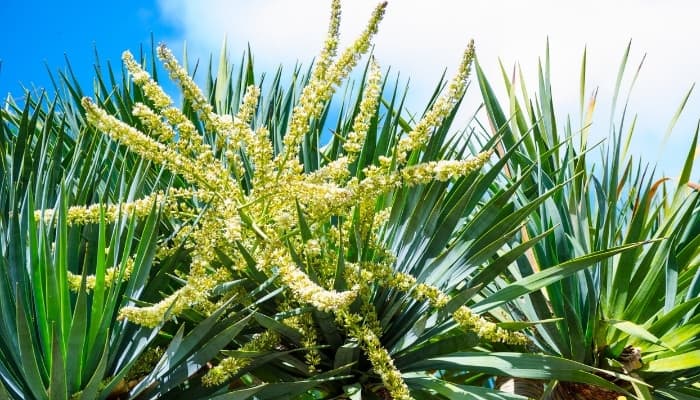
Is Dragon Tree Toxic?
Dragon trees are toxic to cats and dogs if ingested. The plant contains a compound, saponin, which causes digestive distress.
While dragon trees are considered nontoxic for humans, some people can have a sensitivity to the plant. Therefore, it is recommended to not consume any parts of the dragon tree.
Dragon Tree Propagation
The easiest method for propagating a dragon tree is water propagation. In addition, houseplant lovers and children love watching the root growth progress.
1. Take a Stem Cutting
Use a sterilized set of shears or a serrated knife to remove a portion of stem that has leaves. It is best to cut at a 45° angle.
2. Place the Cutting in Water
Place the open end of the stem cutting into water, making sure that none of the leaves are submerged. Use room temperature water.
3. Place the Container in a Bright Location
Place the cutting in water in a location with bright, indirect light.
It is important to avoid direct sun, which scorches the leaves of the cutting and can promote microbial growth in the water.
4. Wait for Roots to Form
It can take a few weeks for roots to form. You will need to change the water every few days to keep it fresh while the roots grow. You want roots that are 2-3 inches in length.
5. Transfer to Soil
Once your dragon tree cutting has roots that are 2-3 inches long, you can transplant the cutting into soil. Don’t use a pot that is too big.
For the first couple of weeks, keep the soil moist while the roots adjust to the soil.
Stem Cutting in Soil
You can skip water propagation by putting your stem cutting directly into soil to propagate. Keep the soil moist while roots are forming.
To determine when the roots have been established, gently tug upward on the dragon tree. If there is resistance, the roots have started to grow throughout the soil.
Repotting a Dragon Tree
Dragon trees are slow growers that do not need to be repotted frequently.
Some people choose to keep their tree the same size by removing some of the roots and replacing the soil instead of transplanting the dragon tree into a larger container.
When to Repot a Dragon Tree
The number one indicator that it is time to repot your dragon tree is when the roots are growing up out of the soil or down out of the drainage holes.
You may also notice stunted growth.
Regardless of indicators, you should repot your dragon tree every 2-3 years to refresh the soil for optimal nutrients and water retention.
Signs That It’s Time To Repot
- Roots growing up out of the soil
- Roots growing out of the drainage holes
- 2-3 years have passed since the last repotting
- Stunted growth during the growing season
How To Repot Dragon Tree
1. Choose New Pot
Only move up one pot size when repotting your dragon tree.
2. Remove Old Soil
Gently remove the dragon tree from its pot and remove as much of the old soil as possible. Trim off any unhealthy portions of roots.
3. Place Dragon Tree in New Pot
Place the root ball of the dragon tree into the new pot. Place the new soil around the roots, tapping the pot to help the soil settle. Do not pack down the soil too firmly.
4. Water Thoroughly
Water thoroughly once the dragon tree is planted. Place the tree back in its location. It can take 2-4 weeks for the dragon tree to adjust to its new pot.
Dragon Tree Common Problems & Solutions That Work
Dragon Tree Common Pests
The most common pests that affect dragon trees are sap-sucking insects, like mealybugs and scale.
Mealybugs
Signs of Trouble
White, cottony insects can be seen on the plant, especially near the base of new leaves. The leaves may be turning pale or yellow.
Overall, the plant will most likely have diminishing health.
Solution
You can rinse the plant to remove adult mealybugs. Follow up with an insecticidal soap or neem oil treatment (find it here on Amazon) to kill juvenile pests and eggs.
The treatment should be repeated every couple of days until the infestation is under control.
Prevention
Periodically treat the dragon tree with neem oil to help prevent mealybugs from infesting the plant. Don’t allow soil to sit moist for extended periods.
Isolate any plants that get mealybugs to prevent the pests from spreading.
Scale
Signs of Trouble
Scales are small brown insects that look like raised spots on the plant. They are similar to mealybugs, but they remain stationary in a single location on the plant for their adult life.
The leaves may look pale or begin yellowing.
Solution
Scales can be hard to remove because they attach themselves to the plant. Treat the plant with an insecticidal soap or neem oil to kill off adults and eggs.
Keep checking the plant and re-treat as needed.
Prevention
Check your plants frequently for any signs of pests. Avoid overwatering and allowing the soil to remain wet for extended periods.
Dragon Tree Common Diseases
Fusarium Leaf Spot
Signs of Trouble
Leaves will have reddish-brown spots, sometimes with a yellow ring. The affected leaves will start to die off.
Solution
Treat the plant with a topical fungicide, such as this organic copper fungicide. You might need to do multiple applications, but in most cases one treatment is enough.
Prevention
Do not mist the leaves or water from above. When watering the plant, place the water directly into the soil. Maintain good airflow around the plant.
Other Common Problems
Leaves Falling Off
Signs of Trouble
When the leaves of the dragon tree are falling off, it’s usually the lower and older leaves that will fall off first.
Solution
It is normal for dragon trees to drop older leaves as it produces new growth, so this might not be an issue.
However, losing leaves can always been a sign of overwatering. Allow the soil to dry out before watering again.
Prevention
Maintain an appropriate watering schedule. Water when the top 2 inches of soil are dry. Fertilize during the growing season to minimize the loss of older leaves.
Leaves Drooping
Signs of Trouble
The generally erect leaves begin to droop downward.
Solution
Drooping leaves are caused by overwatering or underwatering. Maintain an appropriate watering schedule.
If you have been overwatering and suspect root rot, replant the dragon tree with fresh soil and remove any infected roots.
Prevention
Only water when the top 2 inches of soil are dry. Do not allow the plant to go without water for extended periods.
Dragon Tree Common Questions
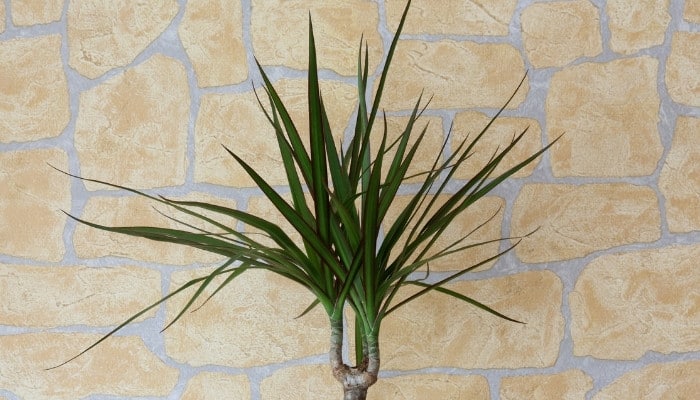
How Fast Do Dragon Trees Grow?
Dragon trees are slow-growing plants. They regularly put out new leaves, but they do not grow taller very quickly.
How Much Does a Dragon Tree Cost?
Dragon trees can cost anywhere from $20-$200 depending on the size of the plant.
Can You Cut the Top Off of a Dragon Tree?
You can prune the top off of a dragon tree and propagate it into a shorter plant. Use water or soil propagation to establish roots.
Do Dragon Trees Grow Fruit?
Dragon trees grown outdoors produce small orange-yellow berries. Houseplant dragon trees rarely produce flowers or berries.
Are Dragon Tree Berries Edible?
There is limited information available about the toxicity of dragon tree berries, though people from the origin locations of the plants have reported a tomato-like flavor to the berries and birds and mammals consume them without any apparent ill effects.
3 Key Tips for Success With Your Dragon Tree
1. Maintain Appropriate Water Levels
Even though your dragon tree can handle periods of neglect, it will thrive when given the appropriate amount of water. Only water the plant when the top 2 inches of soil are dry.
2. Don’t Forget the Fertilizer
Even though dragon trees are slow-growers, they produce a lot of leaves. During the growing season, make sure you fertilize regularly.
3. Keep the Temperatures Up
Once again, don’t let the easy-going nature of the dragon tree allow you to neglect it. Make sure the temperatures don’t drop too low in the home.
Even though your dragon tree will most likely survive, it will drop many of its leaves and look unsightly.
Conclusion
A dragon tree adds height and interest in your home. It is a great houseplant that requires minimal care and will even forgive periods of neglect.
Even if you’re completely new to houseplants, this is a good one to start with. Just be warned – once you get hooked, your collection may grow rapidly.
